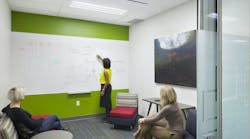Financial institutions have grown accustomed to traversing continuous economic, regulatory, and geopolitical shifts. Today, though, rapid advances in technology—including cryptocurrencies, biometrics, artificial intelligence, open banking, and blockchain—are further disrupting the sector and threatening legacy players in unprecedented ways.
In addition to adapting the new financial workplace to these digital forces, strategists and designers must ensure that it is evolving to accommodate different business drivers, work styles, regional influences, cultures, and employee demographics. These factors are also of deep concern to the leaders of financial institutions, especially when it comes to how they will impact their companies’ real estate and facilities.
“Volume and speed of change are on an increasingly exponential path,” said Chris Bunker, director of strategy, corporate real estate, EMEA, APAC, at the Royal Bank of Canada. “There is a move to project-based work and constant reconfiguration. This is driven from the business to enable project teams to reach their full potential.”
To help our clients and design teams understand the challenges reshaping the industry, HOK’s WorkPlace team recently undertook research on the ways financial institutions have traditionally used their office spaces—and how they can be improved for the future. The result, “The New Financial Workplace,” is a 36-page research report available for free download on hok.com that can serve as a guide for helping companies make informed design decisions about their real estate portfolios and workspaces.
The Talent Imperative
One consistent theme that emerged from our research is the need for financial services companies to win the “war for talent.” With ideas and knowledge driving today’s business, people have become their chief currency.
Despite this “talent imperative,” Silicon Valley and the rest of the tech world is luring many talented professionals away from the financial services sector. These former employees then can turn around and help their new technology-based financial services (fintech) companies compete against them.
These startups, in addition to non-traditional financial competitors such as Google, Amazon, and Alibaba, have less overhead, face fewer regulatory obstacles, and are more agile. As these new entrants to the market cherry pick the high-profit, low-risk parts of their businesses, financial services incumbents are rethinking how and where they work.
In the financial sector, a focus on lean operations, efficient use of space, and rightsizing have long been priorities. However, to compete with their new competitors and begin to retool their people and processes to act and feel more like these fintechs, companies need to hone in on the needs of employees, customers, and partners.
Whether a company is shrinking or expanding, its workplace must be flexible to work for everyone—and support a new, more entrepreneurial culture. Most of all, these workplaces have to be human-centric. Designers have to remember that people aren’t robots; we need to consider which types of environments will enable talented people to be as healthy, happy, and productive as possible, and thus entice them to want to be in the space.
As the nature of financial work continues to evolve, the workplace is adjusting with it. Among the trends highlighted in the HOK report:
Rightsizing the portfolio to achieve cost savings and give employees more workplace choices are top drivers. And providing lots of choices is a leading indicator of whether a workplace will successfully support human performance.
Office space has evolved from being the only place of work to one of many in an entire ecosystem of choices. In fact, two-thirds of survey respondents have a formal distributed work program.
As hierarchy and tenure have become less important, appealing to changing demographics has taken on more significance.
Firms are moving beyond open-plan offices and instead installing more flexible space. Neighborhood-based Choice Environments (NCE) provide neighborhoods for teams to operate out of while still giving the occupants access to a wide variety of work settings.
Financial services companies appreciate and want sustainable design and will increase their focus on employee well-being—though most often without achieving formal LEED for WELL certification.
Elevating the Branch Bank Experience
Although overall branch bank visits are declining as more people do their banking on mobile devices, the retail branch remains the channel with which customers report having the most positive experiences. These branches will endure as a cornerstone of banking and their physical environments must continue to advance the industry’s essential need to embrace a service mindset and elevate the customer experience.
Whether through more personalized services or enhanced selling of financial products, the focus for universal bankers will be to create an exceptional experience that makes customers feel welcome and comfortable. Some branch banks are being designed to look more like coffee shops or co-working spaces. Experiential design elements reinforce branding and communicate the bank’s mission and purpose.
Central Amenity Spaces
Some companies are centralizing amenity spaces to create community hubs for their people. These on-site amenities help motivate employees and improve their work-life balance.
Incorporating elements from hospitality, retail, and higher education can help companies create spaces that support the work-life balance desired by their emerging workforce. This “space fusion,” or blending of sectors, provides highly curated workplace experiences. Tech bars, lounges, coffee counters, and multi-purpose spaces that act as learning spaces are emerging as go-to amenities within the financial sector.
Providing areas where staff can reflect and rejuvenate—such as refresh zones, outdoor space, or contemplative space—can improve productivity and well-being. This was reflected in HOK’s research, which found that the fastest-growing space types for the next three years are likely to include quiet zones or focus rooms and access to adjustable-height desks.
Continue the Dialogue
The one thing we can confidently predict about the future of the financial workplace is that it will continue to change. By engaging in honest, ongoing dialogues about this workplace, we all can work together to plan for and embrace these changes. Out of this turbulence will come untold opportunities.
Kay Sargent, ASID, IIDA, CID, LEED AP, MCR.w, WELL AP, is a senior principal and director of HOK’s WorkPlace practice.
Gordon Wright is the director of HOK’s global WorkPlace practice.
